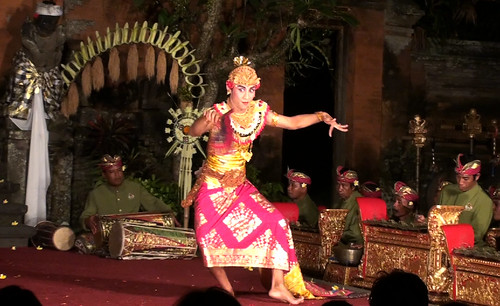
Oleg Tangulilingan, or Bumblebee Dance, is a dance that belongs to a style named Kebyar (Taruna Jaya, the dance I talked about in my previous post, is a Kebyar dance as well). Kebyar dances are characterized by abrupt movements, radical changes in tempo and the requirement of a great ability of expression and energy in the dancer. The Kebyar style emerged in the twentieth century, during and after the golden age of the 1920’s in Bali, when the island became an international spot and foreigner visitors had a decisive influence which resulted in an explosion of creativity among Balinese performing artists .
Ole Tambulilingan was created and choreographed by I Ketut Mario (whom I have mentioned in other posts about Bali (1)), considered one of the pillars of twentieth-century Balinese dance.

According to I Wayan Tibia and Rucina Ballinger (2), Mario created this dance for two young dancers (and later masters) from Peliatan village, I Gusti Raka and I Wayan Rasmin Sampih, when their company was preparing a tour to Europe and the United States in 1952.
Oleg Tambulilingan is a recreation of the bumblebees’s seduction dance. from their entrance to a garden until their final embrace. Within the conventions of Balinese dance the choreography broke with certain established rules, for example, when the woman dancer (it is a male-female couple dance) as a bumblebee “raises her wings” she does it by raising her arms over the shoulders showing her underarms, and no one before had done it.
I’m publishing here a group of photographs (where you can observe very well those dancers’ postures and gestures of hands and eyes), and a video (3 minutes), all from the performance I saw at Ubud Royal Palace in July, 2009.
As a spectator I had a great visual and aesthetic pleasure, both from the the dance and from the music, but that ritual-like feeling I was almost used to when watching performances in Bali wasn’t present; the Kebyar style, in the end, are dances, which recreate parts of Balinese life, through great technical skills and only for the appreciation of the artist.

No comments:
Post a Comment